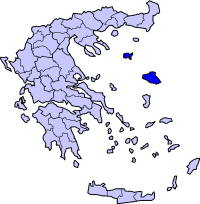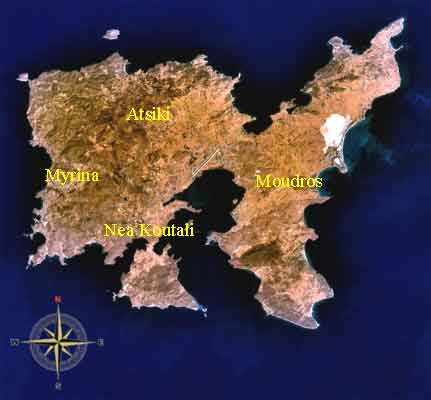.
Administrative Region : North Aegean
Regional unit : Limnos


Kontopouli (Greek: Κοντοπούλι) is a settlement in the northeastern part of the Greek island of Limnos, in the municipality of Moudros. Its 2001 population was 661 for the village and 703 for the municipal district. Its total area is around 37,000 acres (150 km2). The vicinity was founded from a tiny characteristic farming settlement. It is nearly unhabited but it was mentioned during the Byzantine era. One most important that it had Agios Alexandros. It mentioned Dimosia, Agios Georigos Amnion (next to Alyki), Neftina (Νεφτίνα) a bay to its northwest which it had a Turkish ciflik of Haji Pasha, Saravari (Σαράβαρη), Agios Theodoros (with 3 people in 1981) and Geranos or Ageranou.
Settlements
* Agios Alexandros
* Agios Theodoros (ο Άγιος Θεόδωρος) [2001 pop: 290]
Nearest places
* Agios Alexandros, northeast (distance: 5 to 6 km)
* Kalliopi, southeast (distance: nearly 1 km)
* Repanidi, west (distance: 4 to 5 km)
Population
Year Village population Municipal district population
1871 281 -
1920 997 -
1940 1,208 -
1951 1,158 -
1981 809 -
1991 650 -
2001 661 703
The name
The name was known under the name in the Byzantine landowner Kontopoulo (Κοντόπουλο) in which gave a location of buildings, according to a historian Comnenus Pyrogalus?. It continued its information in its communal census of the 19th century that mentioned as I go to Kondopoul’ (πάω στη Κονδοπούλ’ pao sti Kondopul’). Until today, its residents called it Kontopoul’ (Κοντοπούλ’)a writing that was known from the medieval times, a sentence that was said from the medieval pao eis tou Kontopoulou. It became a commune in 1918 and changed its name to Kontopoulion.
According to its village's folklore pronunciation, it was built by residents from Kotsinos and Agios Ypatios. Evidently until the end of the 17th century when Kotsinos was abandoned, many inhabitatns resettled in Kontopouli. With the moving of its inhabitants from Agios Ypatios confirmed from that had its temple.
History
During the Turkish rule, it was mentioned for the first time by Pococke in 1738 as Ontopol (Οντοπόλ). The map of Choiseul-Gouffier in 1788 mentioned in the map as a village, without naming and an 1858 map of Conze mentioned as Kondopuli. From the early 19th century, the village was aerially changed to the center of northeast Lemnos.
In 1857, 370 men between the ages of 18 and 50 paid 11,840 gross, in order to participate in the army, its numbers knew that its settlement's power. Conze mentioned it was a large, high and a comfortable elevation. Its residents receifved others for buying especially ancient currency, in which it ran according to plan. They visited Palaiopoli, Kastrovouni, villages in the ancient and medieval Hephaestia in which began as a chief named Georgie. It planned its area's map.
Kastrovouni
The hill Kastrovouni (Καστροβούνι) or Kastrovouno (Καστρόβουνο, meaning castle on a hill) was mentioned around 1355 and 1356 as the Karakallos Monastery. It had remains of a cellar built in the Medieval times, a church in which taught with an ancient maze of Lemnos which was mentioned by Pliny. It was mentioned that it had marble statues and students, in which it was sacked and used as household items.
In 1884, I. Pantelidis made excavations and founded marble writings. The cellar building was excavated and planned by De Launay in 1894 in which learned the monastery once existed during the Byzantine times, Fredrich in 1904 thought that its rubbles from Kastrovouni was a result of a medieval castle, around the 14th century, in which it took part as earthened and became a basement. In 1917, Sealy mentioned, photographed and studied its spaces of its cellar building by 40x12 to 14 feet (4.3 m). Today, the hill has a chapel known as Saint Spyridon and in Palaiopoli, St. Blas and St. John.
Late 19th century
During that time, the population began to rise as it had settlements near Panagia which it was settled. It had 204 families in 1863, only 190 in 1874. It had 281 people in 1874. From 1863, it had a school in which 60% was a donor and 40% were not donors. The main school building was located near Agios Dimitrios and included students from Kalliopi and Panagia. The old building was demolished in 1948. In 1874, it included 12 other schools around the island, which were used for its council, as a three-levels and from 1903, five-levels.
De Launay (1894, Kondopuli) visited the village askingly to Palaiopoli. It founded poorly, it was known that it settled with poor villages with large buildings, decorated with marbles and used from ancient ruins. Hauttecoeur (1903) mentioned it had a field and farmed wheat, corn and tobacco, Fredrich in 1904 mentined it had a new church.
The monastery of Agios Dimitrios (Saint James) was built around 1892 and 1902 with a lot of architecture including marble and stones from the ruins of ancient Hephaestia. Its foundation in 1892 did not made it, its communal used finance from the school office. The monastery was paid with 600 pounds from Emmanouil and Despoina Dimitriadis. The bell was received by Konstantinos Mavroudis along with Pantelis Vafeas, a resident of Rhodesia (now Zimbabwe), brought 1,000 pounds for its decoration. From its older monastery which had survived different proofs from the main runnings of the monastery.
Emmanouil Dimitriadis (1841–1907) was a trader in Alexandria, other than the monastery, it had a councillor of the Leminan Fraternity and Philanthropic buildings in Egypt and the city. Along with is wife Despoina Vourou, it paid by the student from Kontopouli and surveyed and built a section. It was continued between 1921 and 1922 and paid the daughter of Olga Saktouri in 1925-27 for around ₤400.
20th century
In the last years of Turkish rule, Kontopouli was built with fast pace. It had a post office in which survived a stamp in around 1905 and 1910 with the name Kondopol. The Kontopolians received three members of its council. The rise occurred during the interwar years and the village was the third most populated community on the island until 1940. Its population was 997 in 1920 and rost to 1,208 in 1940. Its population growth made an independent girl's school to opened in 1916-25.
The newly built Dimitriadeios School was not sufficient. In 1930, it opened the Evangelideios School with the price of ₤785 by an old legacy from 1906 by the Egyptian Konstantinos Evangelidis in which continues to run today. From 1937, it opened a kindergarten school. In its later years, its school staff had students, the most popular were Konstantinos Valakos (1921–34), Kalliopi Stavridou (1935–46), Parashos Papairakleous (1936–44), Georgios Paximadas (1937–46), Omiros Boutloukos, Dimitris Kaparos and Dionyssis Papadimitriou (kindergarten).
In 1928, it renewed without pedestal, the bell whichi was built in 1924 (paid by V. Alykatoras). Excavations of Palaiopoli (Hephaestia) and Chloe (Kaveirio) which began in 1926 and founded another air in the town. It opened its athletic council Hephaestia in 1932 and is one of the oldest in the island, its members in which excludes its athletic and soccer/football actions and other outer functions. In 1931, it ran the Kontopouli Reserve Council. From 1925, it featured with its capital a road in which it wrote by its main press (Limnos 460, 10-18-1925).
In 1927, it built a large fountain paid by the community of Kontopouli with beautifol cobblestone road created by Tasos Anivelakis of Thessaloniki. In 1931 it had around 8 lights lit during the night. It had a police station and ran a flour mill and a cotton gin by Ath. Koutsogianni. The main problem was its malaria which affected all the village in Chortarolimni including Romanos, Kalliopi and Panagia. In 1931, its outbreak made it as high as 40% of the population and suffered an epidemic. Its population was friendly and did not list its disposition. Written by Vasos Rodalis (Lemnos, p 866, 9/27 to 874, 12/6/1931).
Modern period
During the dark days of Axis occupation, Kontopouli was ruled by the German army, it suffered a lot of damages to its school and its buildings, it abandoned its rich and poor propertites, and held them hostages. Its military units were the last that left Lemnos in 1944. In its Civil War times, several works survived.
After the war, emigration affected the village, its population fell from 1,136 in 1951 to 650 in 1991. It openend a Christian Council Agia Filothei in 1982 which had run unprinted in 1957.
The village features a regional health center, an angioplasty factory by Dina Despoteri and Zinovia Kontogeorgaki. It ran two bakeries of Evangelos and Konstantinos Stamateris. It still has a café and some small taverns. Its excavations of Hephaestia and its ancient theatre betokened great deays for the future of the city. In Athens, it rans a council in which it wan as a booklet Hephaisteio or Ifestio.
Sources
* The athletic councils Erimakeia in the city with good sport stadium, where for many years was the only with track and field on the island. Receives in honor of a member of the council Kostas Erimakis.
Sources
* Tourptsoglou-Stefanidou Vassiliki, Voyages and Geographical Sources From Lemnos Island (15th-20th Centuries) (Ταξιδιωτικά και γεωγραφικά κείμενα για τη νήσο Λήμνο (15ος-20ος αιώνας) = Taxidiotika ke geografika kimena yia ti niso Limno (15os-20os eonas))
* Belitsos, Theodoros, Lemnos and its villages by Th. Belitsos 1994.
* Lemnos/Limnos Province CD ROM (Cdrom Επαρχείου Λήμνου = CD ROM Eparcheiou Limnou): Lovable Lemnos
* Belitsos, Theodoros: Kontopouli in Lemnos, Limnos, 492 (8-27-2007)
|
Municipalities and communities of the Lesbos Prefecture
Agia Paraskevi | Agiasos | Atsiki | Eresos-Antissa | Evergetoulas | Gera | Kalloni | Loutropoli Thermis | Mantamados | Mithymna | Moudros | Myrina | Mytilene | Nea Koutali | Petra | Plomari | Polichnitos |
| Municipal unit Moudros |
|---|
| Municipal Community Moudros |
| Κουκονήσιο, το (νησίς) |
| Moudros (Μούδρος, ο) |
| Community Kalliopi |
| Kalliopi (Καλλιόπη, η) |
| Community Kaminia |
| Voroskopos (Βοροσκόπος, ο) |
| Kaminia (Καμίνια, τα) |
| Community Kontopouli |
| Agios Alexandros (Άγιος Αλέξανδρος, ο) |
| Agios Theodoros (Άγιος Θεόδωρος, ο) |
| Kontopouli (Κοντοπούλιον, το) |
| Community Lychna |
| Anemoessa (Ανεμόεσσα, η) |
| Lychna (Λύχνα, τα) |
| Community Panagia |
| Kortisonas (Κορτισώνας, ο) |
| Panagia (Παναγία, η) |
| Community Plaka |
| Plaka (Πλάκα, η) |
| Community Repanidi |
| Kotsinas (Κότσινας, ο) |
| Repanidi (Ρεπανίδιον, το) |
| Community Roussopouli |
| Roussopouli (Ρουσσοπούλιον, το) |
| Community Romano |
| Romano (Ρωμανόν, το) |
| Community Skandali |
| Skandali (Σκανδάλιον, το) |
| Community Fisini |
| Agia Sofia (Αγία Σοφία, η) |
| Fisini (Φισίνη, η) |
Greece :
A - B - C - D - E - F - G - H - I - J - K - L - M -
N - O - P - Q - R - S - T - U - V - W - X - Y - Z
| Ancient Greece
Science, Technology , Medicine , Warfare, , Biographies , Life , Cities/Places/Maps , Arts , Literature , Philosophy ,Olympics, Mythology , History , Images Medieval Greece / Byzantine Empire Science, Technology, Arts, , Warfare , Literature, Biographies, Icons, History Modern Greece Cities, Islands, Regions, Fauna/Flora ,Biographies , History , Warfare, Science/Technology, Literature, Music , Arts , Film/Actors , Sport , Fashion --- |
Retrieved from "http://en.wikipedia.org/"
All text is available under the terms of the GNU Free Documentation License



